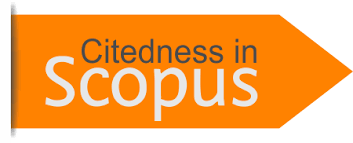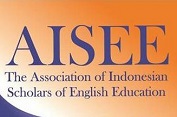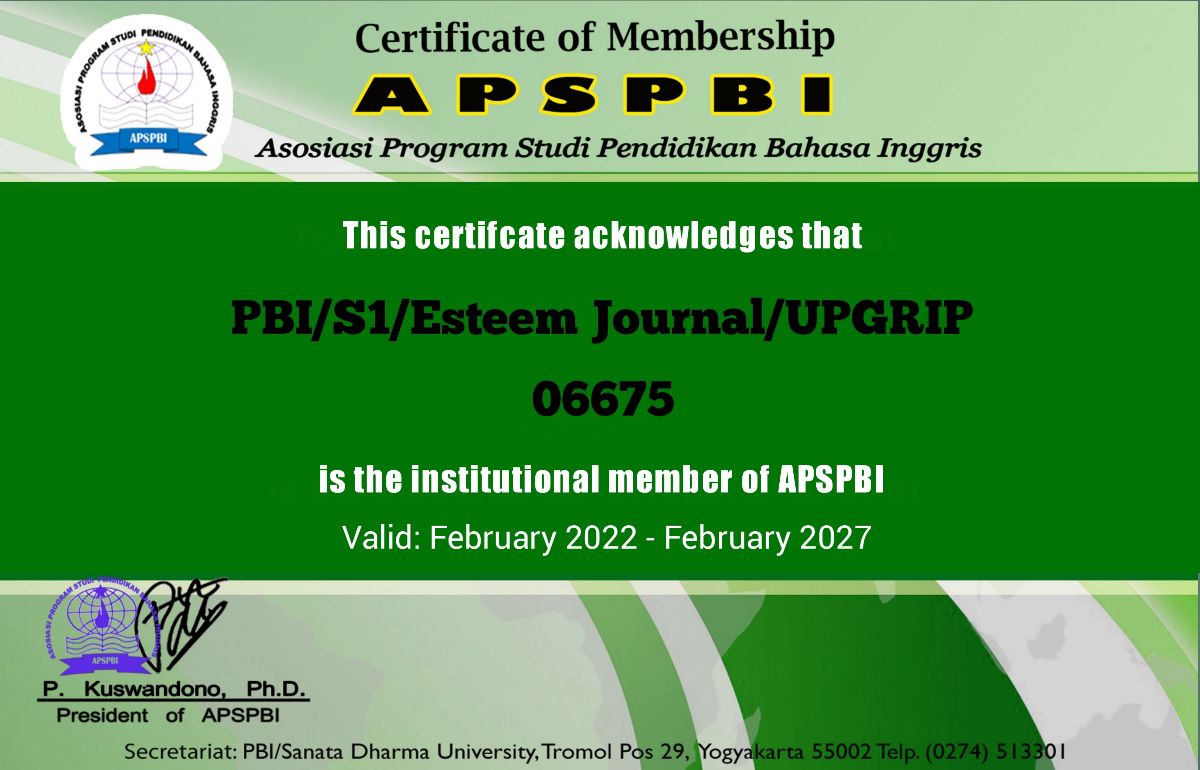THE INFLUENCES OF SCANNING STRATEGY AND READING INTEREST TOWARDS THE EIGHTH GRADE STUDENTS’ READING COMPREHENSION ON LABEL TEXTS OF PGRI JUNIOR HIGH SCHOOL 1 OF PALEMBANG
DOI:
https://doi.org/10.31851/esteem.v7i2.15526Keywords:
The Influences of Scanning Strategy and Reading Interest towardsAbstract
The writer used a strategy calls scanning strategy to solve students’ problems in reading comprehension. Scanning Strategy and reading interest give a significant influence on the students’ reading comprehension achievement especially for students who havea low reading interest. The teacher of English should be more creative to choose the technique for students.The main problem of this study was formulated as follows: ‘Was there any significant difference in reading comprehension achievement between the eighth grade students who had high reading interest taught by using scanning strategy and those who were taught by using conventional technique at Junior High School PGRI 1 of Palembang, was there any significant difference in reading comprehension achievement between the eighth grade students who had low reading interest taught by using scanning strategy and those who were taught by using conventional technique at Junior High School PGRI 1 of Palembang, was there any significant difference in reading comprehension achievement between the eighth grade students taught by using scanning strategy who had high and low reading interest at Junior High School PGRI 1 of Palembang, was there any significant difference in reading comprehension achievement between the eight grade students taught by using conventional technique who had high and low reading interest at Junior High School PGRI 1 of Palembang and were there any interaction effects of scanning strategy and students’ reading interest towards the eighth grade students’ reading comprehension achievement at Junior High School PGRI 1 of Palembang. This study used experimental research. method. The subjects of this study were eighth grade students of PGRI Junior High School 1 of Palembang. While the object of this research is the used 2 x 2 (two by two) factorial designs because there were two factors (Scanning Strategy and reading Interest) and two levels (low and High Reading Interest).
References
Alisa, W. 2018). Improving Students’ Reading Comprehension Using Scanning Technique. (Unpublished Master Thesis) : State University of (PGRI) Palembang.
Anderson, M. (1997). Text Type in English 2. Melbourne: Mackmillan Education Australia.
Arikunto, S. (2013). Prosedur Penelitian: Suatu Pendekatan Praktik. Jakarta: Rineka Cipta.
Baily, S. (2003). Academic Writing: A Pratical Guide for Students: New York: Nelson Thornes Ltd.
Brown, H. D. (2007). Principles Language Learning and Teaching. New York: Pearson Education, Inc.
Brown, H. D. (2010). Language assessment principles and classroom practice. New York, NY: Longman.
reswell, J. W. (2012). Educational research. Boston, MA: Pearson.
Dornyei, Z. (2003). Questionnaire in Second Language Research Construction, Administration, and Processing. New Jersey:Lawrence Erbaum Asscociates, Inc.
Fraenkel, J. R., &Wallen, N. E. (2012). How to design and evaluate research in education (7th ed.). New York, NY: McGraw-Hill.
Fry, E. B. (2000). Skimming & Scanning.New York: Jamestown Publisher.
Gebhard, G. J. (2000). Teaching English as a Foreign or Second Language. New York, WA: The University of Machigan Press.
Grabe, W. (2009). Reading in Second Language Moving from Theory to Practice. New York: Cambridge University Press.
Harmer, J. (2001). The practice of English language teaching (3rded.). Essex: Pearson Education Limited.
Hobsbaum, A. Nikki, Gamble and David, Reedy.(2006). Guiding Reading A Handbook for Teaching Guided Reading at Key Stage 2. London:The Burlington Press.
Jonhson, A. P. (2008). Teaching Reading and Writing. New York: Rowma& Littlefield Education.
Khairuddin, Z. (2013). A Study of Students’ Reading Interests in a Second Language. doi:10.5539/ies.v6n11p160 URL: http://dx.doi.org/10.5539/ies.v6n11p160
Kurmaravadivelu, B. 2006. Understanding Language Teaching. From Method to Postmethod. London: Lawrence Erlbaum Associates, Inc.
Lapp, D. and Douglas Fisher. (2009). Essential Readings on Comprehension- International Reading Association. Chicago: the International Reading Association, Inc.
Larson, J. E. (2009). Educational Psychology Cognition and Learning, Individual Differences and Motivation. New York: Nova Science Publishers, Inc.
Marrero, L. M. (2009). Reading attitudes, habits and performance of third grade ESL students participating in a reading challenge program. Retrieved June 10, 2011, from http://grad.uprm.edu/tesis/martinezmarrero.pdf
McCormick, K. and Jesus Salcedo. 2015. SPPS for Dummies. New Jersey: John Wiley & Sons, Inc.
McKool, S. (2007). Factors that influence the decision to read: An investigation of fifth grade students’ out-of-school reading habits. Reading Improvement, 44(3), 111-132
Mcshane,S. (2005). Applying Research in Reading Instruction for Adults. Washington DC: National Institute For Literacy.
Moats, L. C (1999). A Principle’s Primer for Raising Reading Achievement. New York : the Guilford press.
Munandar, A. et al., (2018). Improving Students’ Reading Comprehension Using Scanning Technique.(Unpublished master thesis). IKIP Siliwangi.
Oakhill, J. Kate Cain and Carsten Elbro. (2015). Understanding and Teaching Reading Comprehension. New York: Routledge.
Wardhana, A. and Arini.(2009). Detik – Detik Ujian Nasional Bahasa Inggris. Jakarta: PT. Penerbit Intan Pariwara.
Zaida, N. (2019). UN SMP/MTs 2019 Bahasa Inggris. Jakarta: Erlangga.
Zemach, D. E. and Lisa A. Rumisek. (2005). Academic Writing. Oxford: Macmillan E.
Downloads
Published
Issue
Section
License
Copyright (c) 2024 Desprayoga, Baginda, Mulyadi

This work is licensed under a Creative Commons Attribution-NonCommercial-ShareAlike 4.0 International License.
Copyright Notice
Authors who publish with this journal agree to the following terms:
In order to assure the highest standards for published articles, a peer review policy is applied. In pursue of the compliance with academic standards, all parties involved in the publishing process (the authors, the editors and the editorial board and the reviewers) agree to meet the responsibilities stated below in accordance to the Journal publication ethics and malpractice statement.
Duties of Authors:
- The author(s) warrant that the submitted article is an original work, which has not been previously published, and that they have obtained an agreement from any co-author(s) prior to the manuscript’s submission;
- The author(s) should not submit articles describing essentially the same research to more than one journal;
- The authors(s) make certain that the manuscript meets the terms of the Manuscript Submission Guideline regarding appropriate academic citation and that no copyright infringement occurs;
- The authors(s) should inform the editors about any conflict of interests and report any errors they subsequently, discover in their manuscript.
Duties of Editors and the Editorial Board:
- The editors, together with the editorial board, are responsible for deciding upon the publication or rejection of the submitted manuscripts based only on their originality, significance, and relevance to the domains of the journal;
- The editors evaluate the manuscripts compliance with academic criteria, the domains of the journal and the guidelines;
- The editors must at all times respect the confidentiality of any information pertaining to the submitted manuscripts;
- The editors assign the review of each manuscript to two reviewers chosen according to their domains of expertise. The editors must take into account any conflict of interest reported by the authors and the reviewers.
- The editors must ensure that the comments and recommendations of the reviewers are sent to the author(s) in due time and that the manuscripts are returned to the editors, who take the final decision to publish them or not.
Authors are permitted and encouraged to post online a pre-publication manuscript (but not the Publisher final formatted PDF version of the Work) in institutional repositories or on their Websites prior to and during the submission process, as it can lead to productive exchanges, as well as earlier and greater citation of published work (see The Effect of Open Access). Any such posting made before acceptance and publication of the Work shall be updated upon publication to include a reference to the Publisher-assigned DOI (Digital Object Identifier) and a link to the online abstract for the final published Work in the Journal.





























